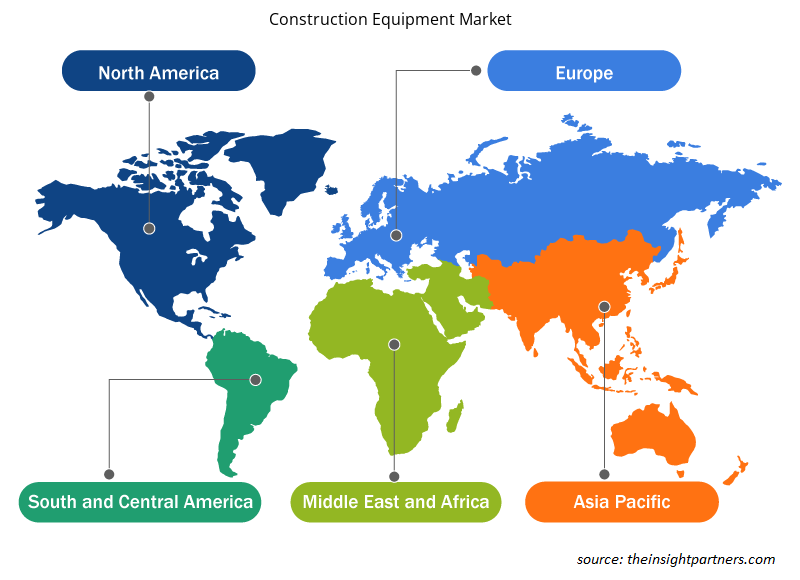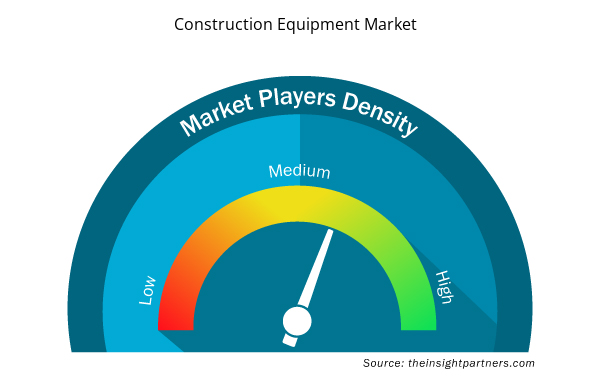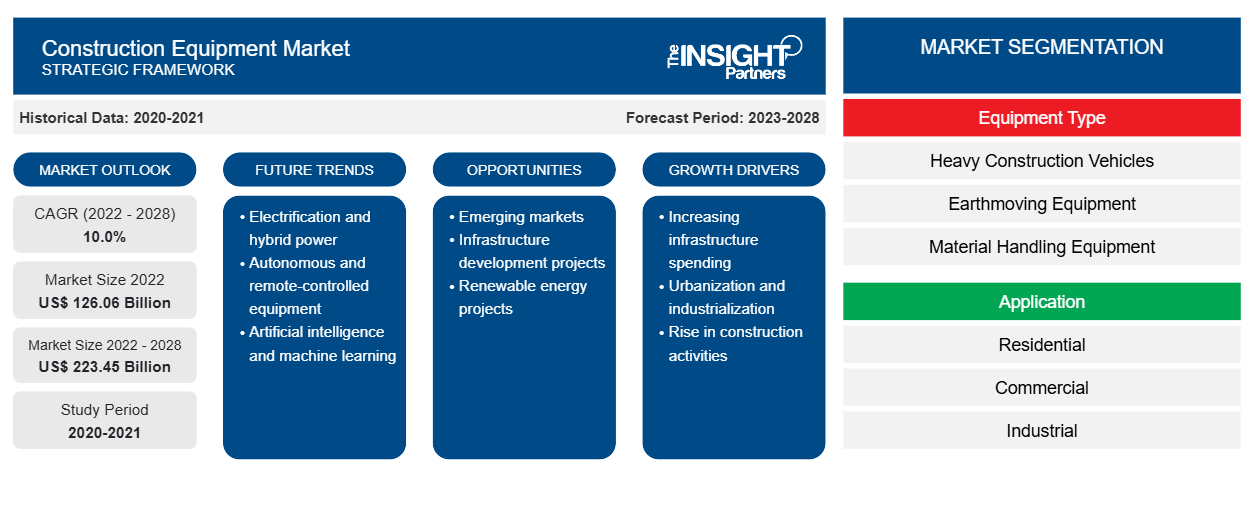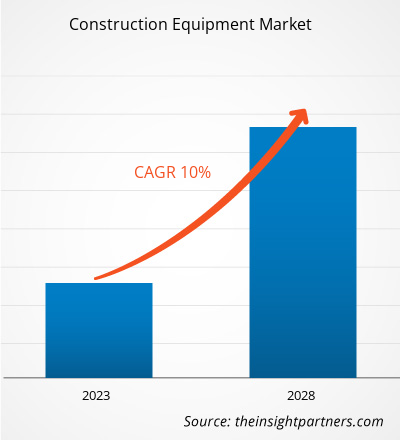建筑设备市场预计将从 2022 年的 1260.628 亿美元增长到 2028 年的 2234.511 亿美元;预计 2022 年至 2028 年的复合年增长率为 10.0%。
专门为执行施工任务(最常见的是土方作业)而开发的重型车辆被称为施工设备。正确使用合适的设备有助于项目的经济性、质量、安全性、速度和及时性。承包商并不总是希望或能够拥有项目所需的所有施工设备。挖掘、挖土、远距离运输、放置、压实、平整、推土、平整和运输是任何建筑项目建设的主要过程。
各种挖掘任务,如挖掘和移动地面,都是用土方设备进行的。土方设备有各种形状和尺寸。它们主要用于维修、建筑、提升、农业和拆除目的。挖掘机是带有铲斗、臂、旋转驾驶室和可移动履带的土方机械。反铲挖土机,又称后铲或反挖机,是一种挖掘设备,其挖斗连接到两部分铰接臂的末端。装载机是一种建筑机械,用于将沥青、拆除废料、泥土、雪、饲料、碎石、原木、原矿、再生材料、岩石、沙子和木屑等材料移动或装载到另一种机械上。
定制此报告以满足您的需求
您可以免费定制任何报告,包括本报告的部分内容、国家级分析、Excel 数据包,以及为初创企业和大学提供优惠和折扣
- 获取此报告的关键市场趋势。这个免费样品将包括数据分析,从市场趋势到估计和预测。
建筑设备市场的主要利益相关者包括建筑设备原材料、供应方的建筑设备制造商和需求方的建筑设备最终用户。近年来,尤其是住宅和商业建筑对建筑设备的需求不断增加,预计这将推动未来五年建筑设备市场的增长。卡特彼勒、约翰迪尔、小松、沃尔沃和利勃海尔是主要的建筑设备供应商。除了这些主要的生态系统参与者之外,还有其他几个外围利益相关者在推动技术进步和这些产品在多个行业的采用方面发挥着至关重要的作用。
COVID-19 疫情对建筑设备市场的影响
2020 年,新冠疫情阻碍了建筑活动。结果,全球建筑设备销量下降。基础设施投资、住宅、商业和工业建筑、地下和井道建设以及机构支出影响了建筑设备制造商。美国、英国、中国和印度是受影响最严重的国家。根据国际建筑集团的数据,2020 年,超过四分之一的项目(22.7%)的交付延迟超过 250 天,超过十分之一的项目(13.4%)的交付延迟超过一年。然而,医院和其他医疗设施、实验室以及航运和物流基础设施的项目供应有限。此外,一些国家已开始逐步恢复包括建筑业在内的各行各业的活动。印度和中国已启动工业和商业建设项目。2021 年 4 月,随着各国开始实施新项目,工业产出自 2021 年 1 月以来首次攀升。因此,对挖掘机、反铲装载机、压实机、推土机和其他建筑设备的需求激增。
市场洞察
新冠肺炎疫情后增加基础设施投资
由于 COVID-19 疫情,全球经济活动受到严重抑制。2020-21 年期间,基础设施投资巨大,为基础设施行业增长提供了动力。发电、国家公路建设、铁路和航运货物方面的基础设施投资推动了对建筑设备的需求。在新兴经济体中,煤炭、原油、钢铁和水泥等一些核心基础设施行业在 2021 年呈现增长指数。这些因素对建筑设备市场增长产生了积极影响。基础设施投资对产品开发具有长期影响,从长远来看可以促进 GDP,尽管这些影响的规模尚不清楚。大多数国家,特别是中东国家,已经建立了四边经济论坛,重点关注该地区的基础设施发展项目。为了促进员工和消费者之间的沟通,企业使用数字解决方案和渠道。政府和教育机构也这样做了。
设备类型细分洞察
由于越来越多的商业、住宅和工业项目需要重型工具和机械来完成工作,因此建筑设备的使用量比以往任何时候都要大。在大型项目中,重型建筑设备用于各种任务。重型设备类型的选择取决于项目的范围和成本。这些因素促进并加快了施工过程。挖掘机是建筑行业中一种重要且经常使用的设备。
应用程序细分洞察
根据应用,建筑设备市场细分为住宅、商业和工业。一种称为沥青混合厂的建筑工具用于生产用于道路建设项目的涂层路石和其他类型的沥青混凝土。压路机本质上是压实机式工程机械,在修建道路和地基时压下泥土、砾石、混凝土或沥青。为了为摩天大楼和其他需要深基础的大型工业综合体安装预制桩,桩钻孔机用于在施工现场创建垂直孔,从而促进了建筑设备市场的增长。
建筑设备市场参与者专注于新产品创新和开发,通过整合先进技术和功能来与竞争对手竞争。2022 年 6 月,卡特彼勒公司宣布其全球总部将从伊利诺伊州迪尔菲尔德迁至该公司位于德克萨斯州欧文的现有工厂。该公司将于 2022 年开始将总部迁至欧文。
根据设备类型,建筑设备市场分为重型建筑车辆、土方设备、物料搬运设备等。根据应用,市场分为住宅、商业和工业。根据地区,全球建筑设备市场分为北美、欧洲、亚太地区、中东和非洲以及南美。
建筑设备市场区域洞察
Insight Partners 的分析师已详尽解释了预测期内影响建筑设备市场的区域趋势和因素。本节还讨论了北美、欧洲、亚太地区、中东和非洲以及南美和中美洲的建筑设备市场细分和地理位置。

- 获取建筑设备市场的区域特定数据
建筑设备市场报告范围
| 报告属性 | 细节 |
|---|---|
| 2022 年市场规模 | 1260.6亿美元 |
| 2028 年市场规模 | 2234.5亿美元 |
| 全球复合年增长率(2022 - 2028) | 10.0% |
| 史料 | 2020-2021 |
| 预测期 | 2023-2028 |
| 涵盖的领域 | 按设备类型
|
| 覆盖地区和国家 | 北美
|
| 市场领导者和主要公司简介 |
|
建筑设备市场参与者密度:了解其对业务动态的影响
建筑设备市场正在快速增长,这得益于最终用户需求的不断增长,而这些需求又源于消费者偏好的不断变化、技术进步以及对产品优势的认识不断提高等因素。随着需求的增加,企业正在扩大其产品范围,进行创新以满足消费者的需求,并利用新兴趋势,从而进一步推动市场增长。
市场参与者密度是指在特定市场或行业内运营的企业或公司的分布情况。它表明在给定市场空间中,相对于其规模或总市场价值,有多少竞争对手(市场参与者)存在。
在建筑设备市场运营的主要公司有:
- 卡特彼勒公司
- 凯斯纽荷兰工业公司
- 小松有限公司
- 利勃海尔
- 特雷克斯公司
免责声明:上面列出的公司没有按照任何特定顺序排列。

- 了解建筑设备市场顶级关键参与者概况
建筑设备市场 – 公司简介
- 卡特彼勒公司
- 凯斯纽荷兰工业公司
- 日立建机株式会社
- JC Bamford 挖掘机有限公司
- 迪尔公司
- 小松制作所
- 利勃海尔国际德国有限公司
- 特雷克斯公司
- 沃尔沃建筑设备公司
- 中联重科股份有限公司
- 历史分析(2 年)、基准年、预测(7 年)及复合年增长率
- PEST 和 SWOT 分析
- 市场规模价值/数量 - 全球、区域、国家
- 行业和竞争格局
- Excel 数据集



Report Coverage
Revenue forecast, Company Analysis, Industry landscape, Growth factors, and Trends

Segment Covered
This text is related
to segments covered.

Regional Scope
North America, Europe, Asia Pacific, Middle East & Africa, South & Central America

Country Scope
This text is related
to country scope.
常见问题
Asia-Pacific dominated the Construction Equipment Market in 2021 with a share of 36.0%; it would continue to dominate the market during the forecast period and account for 38.4% share by 2028
The global construction equipment market size is projected to reach US$ 223451.09 million by 2028.
The material handling equipment segment led the construction equipment market in 2021.
APAC is the fastest-growing regional market in the global construction equipment market in 2021.
The key players holding the major market share of the construction equipment market are Caterpillar, Komatsu, VOLVO Construction Equipment, John Deere and Liebherr.
The Future trends impacting the construction equipment market are -- Growing Demand for the Artificial Intelligence
The global construction equipment market was valued at US$ 120661.95 million in 2021
The driving factors impacting the construction equipment market are
I. Increasing Infrastructure Investments Post COVID-19 Pandemic
Growing Focus on Public-Private Partnerships (PPP)
Trends and growth analysis reports related to Manufacturing and Construction : READ MORE..
The List of Companies -Construction Equipment Market
- Caterpillar Inc
- CNH Industrial N.V.
- Komatsu Ltd
- Liebherr
- Terex Corporation
- Zoomlion Heavy Industry Science&Technology Co., Ltd.
- J C Bamford Excavators Ltd. (JCB)
- Deere & Company
- AB Volvo
- Hitachi Construction Machinery Co., Ltd.
The Insight Partners performs research in 4 major stages: Data Collection & Secondary Research, Primary Research, Data Analysis and Data Triangulation & Final Review.
- Data Collection and Secondary Research:
As a market research and consulting firm operating from a decade, we have published and advised several client across the globe. First step for any study will start with an assessment of currently available data and insights from existing reports. Further, historical and current market information is collected from Investor Presentations, Annual Reports, SEC Filings, etc., and other information related to company’s performance and market positioning are gathered from Paid Databases (Factiva, Hoovers, and Reuters) and various other publications available in public domain.
Several associations trade associates, technical forums, institutes, societies and organization are accessed to gain technical as well as market related insights through their publications such as research papers, blogs and press releases related to the studies are referred to get cues about the market. Further, white papers, journals, magazines, and other news articles published in last 3 years are scrutinized and analyzed to understand the current market trends.
- Primary Research:
The primarily interview analysis comprise of data obtained from industry participants interview and answers to survey questions gathered by in-house primary team.
For primary research, interviews are conducted with industry experts/CEOs/Marketing Managers/VPs/Subject Matter Experts from both demand and supply side to get a 360-degree view of the market. The primary team conducts several interviews based on the complexity of the markets to understand the various market trends and dynamics which makes research more credible and precise.
A typical research interview fulfils the following functions:
- Provides first-hand information on the market size, market trends, growth trends, competitive landscape, and outlook
- Validates and strengthens in-house secondary research findings
- Develops the analysis team’s expertise and market understanding
Primary research involves email interactions and telephone interviews for each market, category, segment, and sub-segment across geographies. The participants who typically take part in such a process include, but are not limited to:
- Industry participants: VPs, business development managers, market intelligence managers and national sales managers
- Outside experts: Valuation experts, research analysts and key opinion leaders specializing in the electronics and semiconductor industry.
Below is the breakup of our primary respondents by company, designation, and region:

Once we receive the confirmation from primary research sources or primary respondents, we finalize the base year market estimation and forecast the data as per the macroeconomic and microeconomic factors assessed during data collection.
- Data Analysis:
Once data is validated through both secondary as well as primary respondents, we finalize the market estimations by hypothesis formulation and factor analysis at regional and country level.
- Macro-Economic Factor Analysis:
We analyse macroeconomic indicators such the gross domestic product (GDP), increase in the demand for goods and services across industries, technological advancement, regional economic growth, governmental policies, the influence of COVID-19, PEST analysis, and other aspects. This analysis aids in setting benchmarks for various nations/regions and approximating market splits. Additionally, the general trend of the aforementioned components aid in determining the market's development possibilities.
- Country Level Data:
Various factors that are especially aligned to the country are taken into account to determine the market size for a certain area and country, including the presence of vendors, such as headquarters and offices, the country's GDP, demand patterns, and industry growth. To comprehend the market dynamics for the nation, a number of growth variables, inhibitors, application areas, and current market trends are researched. The aforementioned elements aid in determining the country's overall market's growth potential.
- Company Profile:
The “Table of Contents” is formulated by listing and analyzing more than 25 - 30 companies operating in the market ecosystem across geographies. However, we profile only 10 companies as a standard practice in our syndicate reports. These 10 companies comprise leading, emerging, and regional players. Nonetheless, our analysis is not restricted to the 10 listed companies, we also analyze other companies present in the market to develop a holistic view and understand the prevailing trends. The “Company Profiles” section in the report covers key facts, business description, products & services, financial information, SWOT analysis, and key developments. The financial information presented is extracted from the annual reports and official documents of the publicly listed companies. Upon collecting the information for the sections of respective companies, we verify them via various primary sources and then compile the data in respective company profiles. The company level information helps us in deriving the base number as well as in forecasting the market size.
- Developing Base Number:
Aggregation of sales statistics (2020-2022) and macro-economic factor, and other secondary and primary research insights are utilized to arrive at base number and related market shares for 2022. The data gaps are identified in this step and relevant market data is analyzed, collected from paid primary interviews or databases. On finalizing the base year market size, forecasts are developed on the basis of macro-economic, industry and market growth factors and company level analysis.
- Data Triangulation and Final Review:
The market findings and base year market size calculations are validated from supply as well as demand side. Demand side validations are based on macro-economic factor analysis and benchmarks for respective regions and countries. In case of supply side validations, revenues of major companies are estimated (in case not available) based on industry benchmark, approximate number of employees, product portfolio, and primary interviews revenues are gathered. Further revenue from target product/service segment is assessed to avoid overshooting of market statistics. In case of heavy deviations between supply and demand side values, all thes steps are repeated to achieve synchronization.
We follow an iterative model, wherein we share our research findings with Subject Matter Experts (SME’s) and Key Opinion Leaders (KOLs) until consensus view of the market is not formulated – this model negates any drastic deviation in the opinions of experts. Only validated and universally acceptable research findings are quoted in our reports.
We have important check points that we use to validate our research findings – which we call – data triangulation, where we validate the information, we generate from secondary sources with primary interviews and then we re-validate with our internal data bases and Subject matter experts. This comprehensive model enables us to deliver high quality, reliable data in shortest possible time.


 获取此报告的免费样本
获取此报告的免费样本